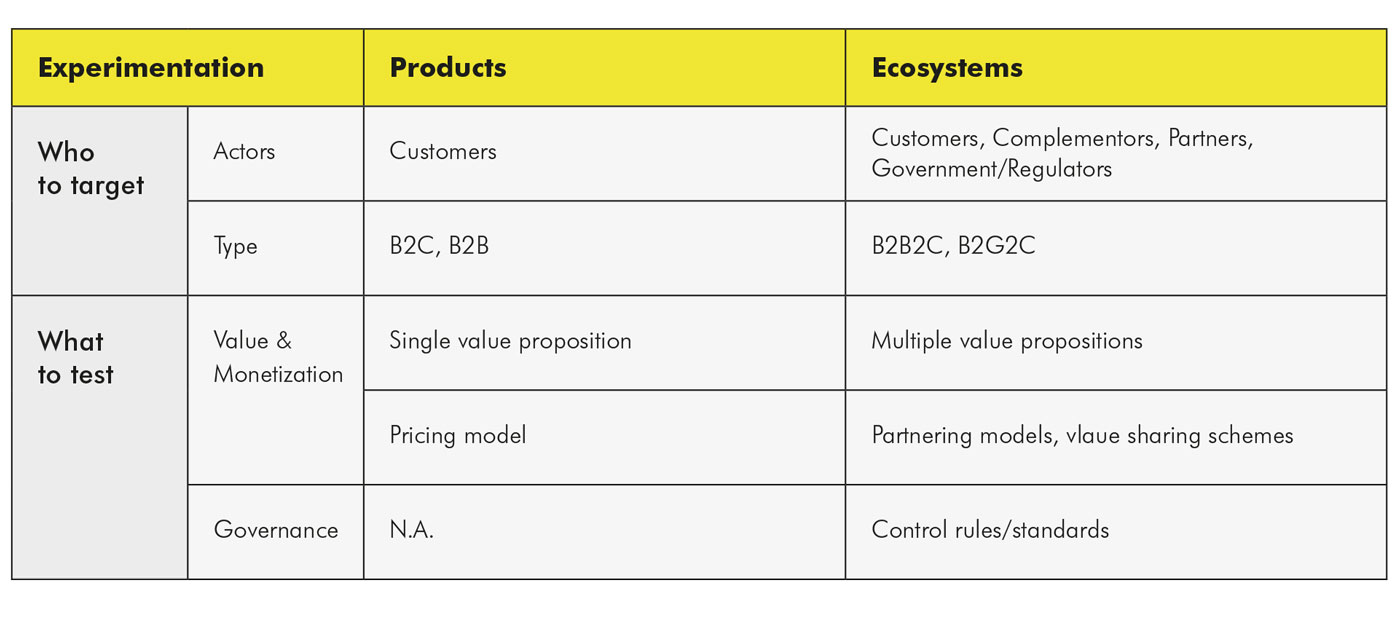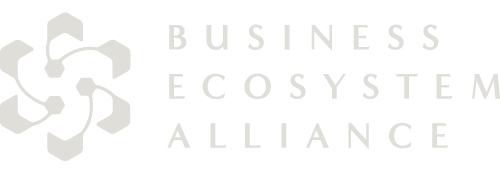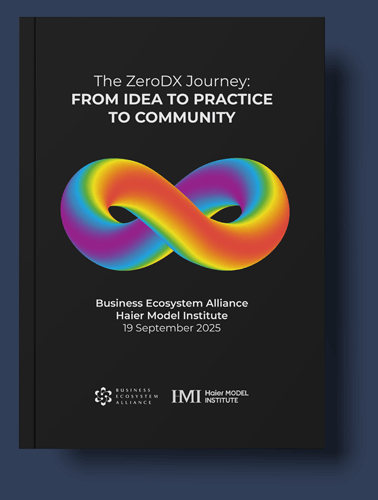A step-by-step approach to experiment with ecosystems
Gabriele Rosani & Elisa Farri
In the earlier article, “Ecosystems: the how factor,” we shared concrete, how-to guidelines to help executives design an ecosystem strategy that can be summarized in a simple one-page tool, the Ecosystem Canvas. Why a one-page tool? Because too often, in our consulting work, we have come across ambitious executives with bold strategy plans in which they aspire to become the Amazon, Google, or Netflix of their industry. Thick slide decks depict them at the center of hyper-complex ecosystems, spanning a multitude of sectors. Not surprisingly, most plans have vanished as soon as they are tested by reality. Delusions of grandeur associated with “can do it all and at once” thinking are a recipe for failure in building successful ecosystems.
Navigating the complexity – and uncertainty – of business ecosystems requires focus on the core starting point and a trial and error mindset to experiment, change modularly, and ruthlessly prioritize.
Design thinking and lean start-up theory have emphasized the importance of testing assumptions on Minimum Viable Products (MVP) when developing new product and business solutions.1 Some of their principles can be extended to business ecosystems, but with caveats. In fact, experimenting with ecosystems is more complex than experimenting with products.
Who to target: When testing a new product, we engage with our target customers (B2C or B2B), while in the case of ecosystems we have to consider heterogeneous agents along a complex B2B2C chain playing different roles, interacting with one another, and making decisions that evolve over time. Moreover, in some circumstances, those agents are typically multilayered organizations with different decision-makers and influencers worth targeting.
The Nespresso system, built around Nestlé’s single-use espresso capsule concept, illustrates the duality of experimentation targets. In addition to traditional customers (in this case, consumers of coffee pods), Nespresso initially explored potential coffee machine manufacturers, to ultimately decide which ones could have the permission to make Nespresso-compatible machines.
What to test: In the case of a new product or business solution, the test centers on its unique value proposition: from the benefits that it can bring to the customers, to the monetization approach. In the case of ecosystems, there are multiple value propositions to test, one for each main complementor; same for the potential partnering models and related value-sharing mechanisms.
A key step of Nespresso’s experimentation journey was testing different value propositions and monetization strategies: from capsule sale price to machine producers’ royalties. To create strong links among the various ecosystem actors and to make it complex for outsiders to break in, Nespresso defined a shared set of rules and standards for firms to make their products and services compatible.
Governance is another key element worth experimenting with. While for products rules and conditions are set by the firm that fully controls the offering, in the case of an ecosystem, there is a wide spectrum of governance mechanisms among the various actors. Apple is a case in point. It took years to learn how to best govern the long tail of app developers for the iPhone ecosystem.

Starting from our one-page ecosystem canvas tool (see page 36) and drawing on key principles of design thinking and lean start-up, we have developed a three-step approach to experiment with ecosystems that we have applied with our clients in both B2B and B2C sectors.
- Spread your experimental eggs across several baskets: Do not limit to one canvas. Rather than putting all your bets on one ecosystem canvas, develop two or three ecosystem scenarios addressing a key market friction or customer pain-point. Detail the strategic options in separate ecosystem canvas In the initial stages, it’s important to focus on the big picture, rather than going into the details and pretending to complete all the boxes of each canvas tool. The main goal is to help you manage the risks you might encounter down the experimentation road, while providing guidance in terms of the most critical assumptions that if not tested might kill the related scenario early.
For a large German chemical company, we filled canvases for three different hypotheses of future ecosystems: the first aimed at solving supply chain frictions, the second at recommending suitable formulations for customers from multiple providers of chemical ingredients, the third at disintermediating the chain to reach the final consumers. All scenarios were driven by very relevant pain-points in the industry that only an ecosystem, not a single company alone, could solve.
- Test key assumptions of your canvases: Make it For each canvas, list the key assumptions to test. Typically, key assumptions relate to the shared functionality and the few selected complementors representing the core of the ecosystem strategy. Why focus on the core? Because it allows you to move faster and more effectively: if the core proves unfeasible or unattractive, you can redirect your efforts to the other scenarios. During exploratory discussions with target stakeholders, the canvas can be a powerful tool to guide the discussion and collect input and feedback in a structured way. Other tools, such as situational mock-up videos can help interviewees better visualize the ecosystem strategy.
During the experimentation phase for our German client, we coupled in-depth customer interviews with half-day stakeholder workshops. To make the tests as real as possible, we showed a video with a lab technician interacting with an Al-powered device to search and order samples of ingredients based on very specific functional needs. The video proved effective both when talking with customers (Lab technicians) as well as with complementors (providers of other ingredients necessary for the formulation).
- Capture learnings: Be ready to pivot several times. Most of the companies that today orchestrate successful ecosystems have been through (painful) experimentation Learning is a key element of every ecosystem experimentation. Run frequent internal review sessions on the key assumptions – at least every two or three weeks. Do not wait for all experiments to be completed, especially when early signals show that some assumptions are not valid. Recently, one of our clients in the energy sector discovered that the underlying assumptions for two of the three ecosystems proved not valid: one was promptly stopped even before completing the cycle of interviews, while the most valuable elements of the second were partly embedded into the most promising third ecosystem. While some of your initial concepts are likely to be dropped due to unforeseeable concerns or objections, others might spin in unpredictable ways or may benefit from an acceleration because the partner is eager to take part.
Companies that applied this step-by step experimental approach had two main benefits. First, they escaped the trap of unrealistic grandeur: rather than investing a lot of time on picturing a full-fledged Amazon-like vision, executives could focus on a small set of clearly scoped scenarios and options built around a relevant friction or pain-point. Second, they learned how to make choices based on reality checks, without worrying about killing some of their initial ideas. Having other eggs spread across multiple baskets (i.e. canvases) allowed them to save time and money and find unexpected new paths.
Business ecosystems may have become the new buzzwords in strategy discussions. Many companies are fascinated about new growth strategies spanning sectors and try elaborating bold visions. But very few walk the talk and even fewer turn out to be successful. We believe that by taking an experimental approach, companies can lay more sound foundations for a future business ecosystem strategy that works for the bottom line.
Elisa Farri is an associate partner at ECSI Consulting (ecsi-consulting.com). She is based in Milan.
Gabriele Rosani is a senior manager at ECSI Consulting (ecsi-consulting.com). He is based in Milan.
Footnotes:
1 Gabriele Rosani, “How large companies can adapt lean thinking in research and development,” LSE Business Review, https://blogs.lse.ac.uk/businessreview/2017/11/06/how-large-companies-can-adopt-lean-thinking-in-research-and-development/


